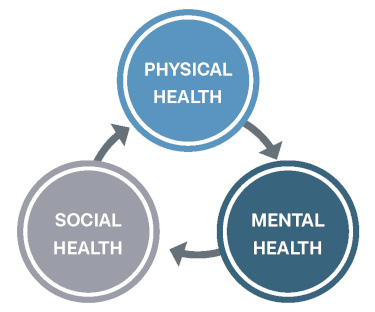Supporting practitioner wellbeing: Practice Guide (2022)
This guide aims to support you, as a social care practitioner, to repair, maintain, grow and sustain your mental health and wellbeing, to allow you to flourish and continue to support others effectively in your professional practice. Drawing on up-to-date research and resources this guide will help you develop a self-care action plan and assemble a personalised toolbox of strategies that will support your physical, mental and social wellbeing.
This is a quick-read version of the Supporting practitioner wellbeing: Practice Guide (2022), which highlights its key messages. To gain a greater understanding of the topic you can download and read the full tool, which includes references.
Introduction
This guide aims to support you, as a social care practitioner, to repair, maintain, grow and sustain your mental health and wellbeing. This will allow you to flourish and continue to support others effectively in your professional practice.
The full version of the guide includes evidence-informed approaches and exercises under the following sections to support you to design your own self-care plan and toolbox:
Self-care: the cornerstone of resilience and wellbeing
Social care practitioners often struggle to prioritise their own wellbeing over meeting the needs of others (Kinman & Grant, 2020). They typically prioritise practices that enhance the wellbeing of their professional self (i.e. to enable them to support others) over those that promote personal self-care (Miller et al., 2019). Reflecting the biopsychosocial model of health (Sarafino & Smith, 2021), the strategies outlined in this guide are designed to help you support the three ’pillars’ of health: physical, mental and social.

The three pillars of health
Self-care: repair maintenance and growth
Your self-care plan should reflect the need to repair, maintain and grow your wellbeing.
Repair: the remedial actions we take when we notice signs of stress. There are some common symptoms, but people react differently – some respond emotionally (e.g. become irritable, feel overwhelmed or lose confidence), behaviourally (e.g. become indecisive, isolate themselves from others or turn to alcohol or other substances, or physically (e.g. experience headaches, insomnia or food cravings).
Maintenance: keeping ourselves ‘ticking over’ and operating at full capacity.
Growth: building the capacity for resilience, to feel and perform at our best.
Avoiding burnout
How can you tell if you are burning out?
Early warning signs
- Cognitive changes: difficulty making decisions; lack of concentration; increased cynicism, criticism and suspicion of others; doubts about one’s own competence.
- Emotional changes: anger and frustration; anxiety and fear; feelings of meaningless and being under-valued; loss of enjoyment of work and sense of doing a good job.
- Physical changes: insomnia and fatigue; unexplained symptoms such as headaches; increased vulnerability to illness.
- Social changes: feeling alienated from other people; feeling isolated.
- Behavioural changes: lack of empathy; loss of sense of humour; depersonalising people; self-medication with food, alcohol or drugs.
Common causes
- Chronically high workload; fast pace of work; long working hours.
- Lack of resources and support from managers and colleagues.
- Unclear job expectations.
- Stretching yourself too thinly.
- Poor work-life balance; no opportunities to recover from work demands.
- Weak boundaries; over-involvement in work.
- Perfectionism; idealism; a rescuing tendency.
Self-compassion
Neff (2016) identifies three elements of self-compassion.

- Self-kindness vs self-judgment: being warm, patient and understanding towards ourselves when we suffer or feel inadequate rather than self-critical and hostile: ‘When I’m going through a very hard time, I give myself the care and tenderness I need.’
- Common humanity vs isolation: recognising that personal suffering and feelings of failure are part of being human, and not something that differentiates us from others: ‘When things are going badly for me, I see my difficulties as part of life that everyone goes through.’
- Mindfulness vs over-identification: taking a balanced and accepting approach to negative emotions, so our feelings are neither avoided nor exaggerated: ‘When something upsets me, I try to keep my emotions in balance.’
Lifestyle and self-care
Some points to help you identify and consider what helps you to manage energy and target areas for change are shown below.
I feel better when...
I have seven to eight hours of sleep.
I get enough exercise.
I take regular breaks to recoup my energy.
I am able to concentrate on the task in hand rather than be distracted by other things.
I attend to longer-term issues rather than react to crises and demands.
I take time for reflection and creative thinking.
I frequently express my appreciation to others and enjoy my own achievements.
I am able to allocate my time and energy to things that are important to me.
Mindfulness
Mindfulness refers to paying attention in a particular way: on purpose, in the present moment and non-judgmentally (Kabat-Zinn, 2005).
The guide highlights some mindfulness exercises such as:
Focus on a single task. Place your attention on one experience or activity at a time. As with mindful breathing, if your mind wanders, return to the task in hand. You are likely to accomplish more than you would trying to multi-task and make fewer errors.
Building your support network
Social support is one of the most important health-promoting resources. Social care practitioners who feel better supported tend to be more resilient and mentally and physically healthy (Grant & Kinman, 2014; Sánchez-Moreno et al., 2014). Emotional support from colleagues and peer support groups are crucial in helping practitioners maintain a sense of wellbeing and purpose, particularly during these demanding and uncertain times.
Keeping a healthy work-life balance
Some suggestions on how to improve your work-life balance:
- Have regular breaks away from your desk: this will get you into the habit of switching off.
- Get up and move around throughout the day: this will improve your focus and avoid musculoskeletal problems.
- Get outside in the daylight: if possible, adjust your working hours so you can take a daily walk.
- Have an unwinding ritual: for the last 30 minutes, only start jobs that you can complete easily; spend the time on digital housekeeping, or clearing your desk.
Assembling your own toolbox
Self-care is essential for continued health and wellbeing and for optimum functioning at work. This guide will help you build your personal toolbox with self-care strategies to support your physical, mental and social health.
Professional Standards
PQS:KSS - Organisational context | Organisational context
CQC - Caring | Safe
PCF - Contexts and organisations
RCOT - Health and safety




